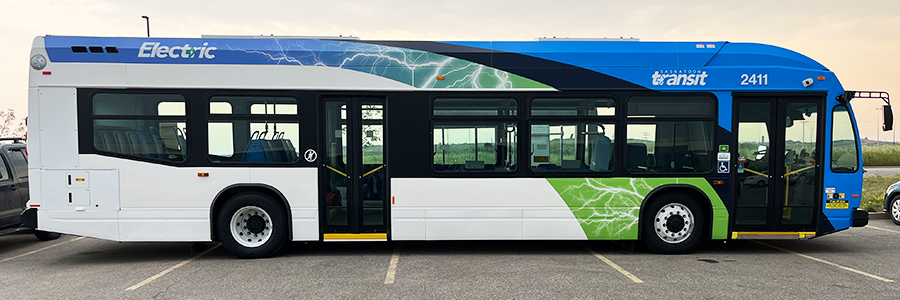Zero Emissions Buses
Zero emissions bus study
The Canadian Urban Transit Research and Innovation Consortium (CUTRIC) was contracted in 2024 through the National Planning Service for the Government of Canada’s Zero Emission Transit Fund to assess Saskatoon Transit's readiness to transition to a fully ZEB fleet. CUTRIC found that converting the diesel bus fleet to zero emissions buses is not financially feasible for Saskatoon Transit in the short or medium term. Read the May 6, 2025 news release: Saskatoon Transit analyzes readiness for a zero emissions bus fleet.
A mix of battery electric and hydrogen-powered buses was recommended; however, both rely significantly on the power grid for charging or fuel production. Saskatchewan power plants use fossil fuels such as coal and natural gas to generate electricity, which emit greenhouse gases and offset the benefits of reduced tailpipe emissions from zero emission buses.
Financial cost is also a significant factor, as the total life cycle cost (15 years) of a fleet of 100% Hydrogen Fuel Cell Electric Buses would cost $1.1 billion using current prices and $18.2 million for facility retrofits. A fleet of 100% battery-electric buses would have a total life cycle cost (15 years) of $479.2 million and require $47.7 million in facility costs and on-route charging infrastructure.
Saskatoon Transit is monitoring the advancement of ZEB technology and environmental improvements to the Saskatchewan power grid that may make the transition to zero emissions buses more cost-effective and beneficial. Read the administrative report to the May 21, 2025 City Council Regular Meeting: Saskatoon Transit Full-Fleet Zero Emission Bus Implementation Plan - CUTRIC Report.
The City of Saskatoon's targets for Saskatoon Transit in the Low Emissions Community Plan and Climate Action Plan are to electrify 100% of the transit fleet by 2030 to reduce greenhouse gas (GHG) emissions.
Battery-electric buses

Saskatoon Transit added two new Nova LFSe+ battery-electric buses to its public transit fleet in July 2024, as part of the broader $115.4 million revised 2023-2031 fleet renewal strategy. As the first battery-electric buses in Saskatchewan, these vehicles are an exciting step toward building a transit fleet that meets current and future ridership demands and our commitment to sustainability and environmental leadership. The Electric decals on bus numbers 2410 and 2411 are easy to spot and ready to provide a greener, more efficient travel option.
The Nova LFSe+ battery-electric buses are designed to provide a modern, sustainable, and comfortable transit experience for all passengers. Once charged, the bus can run on electric power, producing close to zero greenhouse gas emissions.
- These 40’ battery-electric bus models are low-floor, long-range buses powered by a six-pack battery configuration. The life expectancy of these buses is 12-15 years.
- Each bus can accommodate up to 59 passengers, with seating capacity for up to 41 passengers.
- On average, the Nova LFSe+ can travel more than 300 km before requiring a recharge. The range of a bus can vary significantly due to various factors, including temperature, weather, topography, driving behaviour, number of passengers, and the battery's health.
- Buses are charged for approximately three hours at the Civic Operations Centre using an electric charging station when parked.
- To ensure reliable performance during winter, the buses are equipped with a hybrid-diesel auxiliary heater to prevent range reduction. Range may be reduced in extremely cold weather.
Battery-electric pilot project
The Saskatchewan Research Council (SRC) presented an electric bus feasibility study in 2019 that outlined potential operating savings, high-level life cycle costing, carbon and greenhouse gas reductions and environmental benefits for Saskatoon Transit. Based on these findings, Saskatoon Transit leased a battery-electric bus with partial funding from the Government of Canada's Green Municipal Fund, and SRC studied the performance from November 2020 to October 2021 to evaluate the bus' performance under all conditions on regular bus routes during peak morning and afternoon hours.
Findings: The bus operated reliably in both cold and hot weather. The HVAC system was powered from the electric battery and consumed more energy than the bus motor during the coldest months of the year, resulting in a lower effective range per charge. Greenhouse gas emissions were approximately 47% lower for the electric bus during the trial than for a comparable diesel bus over the same distance. The total cost of ownership of a Saskatoon-based electric bus is expected to be lower than a diesel bus. Based on the analysis of the data collected during this project, SRC concluded that converting their bus fleet from diesel to electric is a viable option for Saskatoon Transit.
Read the March 7, 2022 administrative report to the Standing Policy Committee on Transportation: Saskatoon Transit Battery Electric Bus Trial Performance Results.